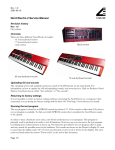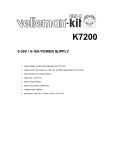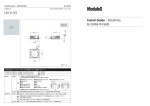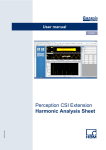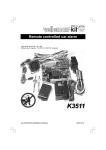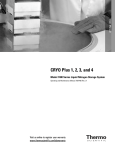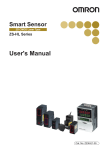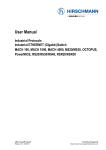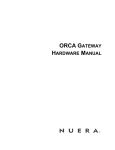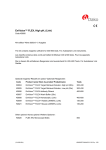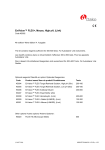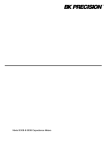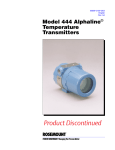Download K8009
Transcript
Total solder points: 775 Difficulty level: beginner 1o 2o 3o 4o 5þ advanced Multifunctional clock display Features : R R R R R R R R R R R R R R K8009 6 x 36mm high digits. Time, date & temperature indication, selectable with toggle option. 1 sec. resolution chronometer with lap function. Count down function to a specific date. Scoreboard function (two players or teams, count up to 199). Random generator from 00 to 99. 2 digit dice. Hour chime option. Counter display. Relay output for temperature control or time alarm. US or Europe display option: time, date, degrees Celsius or Fahrenheit. Wireless remote control for all functions (wired remote possible). Optional enclosure type B8009. Optional extra remote type K6706A, K6706B or K6706G. Specifications : — — — — — — — — Fixed 433.92 MHz transmitter frequency, as required by law. Key chain remote control included. Temperature indication from -20 to +70 ºC (resolution 1º). Temperature indication from 0 to +150 ºF (resolution 2º). Memory backup option: 9V battery or rechargeable battery T331 Relay output: 1A / 24V max. Supply: 12VDC/300mA power supply (adapter type PS1203). Dimensions : 252 x 80mm (without enclosure). Modifications reserved ILLUSTRATED ASSEMBLY MANUAL H8009IP-3 Assembly hints 1. Assembly (Skipping this can lead to troubles ! ) Ok, so we have your attention. These hints will help you to make this project successful. Read them carefully. 1.1 Make sure you have the right tools: • A good quality soldering iron (25-40W) with a small tip. • Wipe it often on a wet sponge or cloth, to keep it clean; then apply solder to the tip, to give it a wet look. This is called ‘thinning’ and will protect the tip, and enables you to make good connections. When solder rolls off the tip, it needs cleaning. • Thin raisin-core solder. Do not use any flux or grease. • A diagonal cutter to trim excess wires. To avoid injury when cutting excess leads, hold the lead so they cannot fly towards the eyes. • Needle nose pliers, for bending leads, or to hold components in place. • Small blade and phillips screwdrivers. A basic range is fine. For some projects, a basic multi-meter is required, or might be handy 0.0 00 1.2 Assembly Hints : ⇒ Make sure the skill level matches your experience, to avoid disappointments. ⇒ Follow the instructions carefully. Read and understand the entire step before you perform each operation. ⇒ Perform the assembly in the correct order as stated in this manual ⇒ Position all parts on the PCB (Printed Circuit Board) as shown on the drawings. ⇒ Values on the circuit diagram are subject to changes. ⇒ Values in this assembly guide are correct* ⇒ Use the check-boxes to mark your progress. ⇒ Please read the included information on safety and customer service * Typographical inaccuracies excluded. Always look for possible last minute manual updates, indicated as ‘NOTE’ on a separate leaflet. 2 Assembly hints 1.3 Soldering Hints : 1- Mount the component against the PCB surface and carefully solder the leads 2- Make sure the solder joints are cone-shaped and shiny 3- Trim excess leads as close as possible to the solder joint AXIAL COMPONENTS ARE TAPED IN THE CORRECT MOUNTING SEQUENCE ! REMOVE THEM FROM THE TAPE ONE AT A TIME ! Velleman hereby certifies that the device K8009 meets the essential requirements and all other relevant stipulations of directive 1999/5/ EG and 1995/5/EC. For the complete conformity declaration check out : http://www.velleman.be/downloads/doC/CE_K8009.pdf 3 4 P E Verde Blu Viola Grigio Bianco 5 6 7 8 9 S Brun Svart Blå Grön Kulta Dourado Oro Grå Guld Silver Valkoinen Vit B Oro Blanco Harmaa Hopea Branco Sininen Vihreä Morado Purppura Lila Azul Cinzento Gris Violeta Azul Verde Naran- Oranssi Orange jado Amarelo Amarillo Keltainen Gul Verde DK 4K7= ( 4 - 7 - 0 - 1 - 1 ) 1% N Rød Brun Sort Guld Sølv Hvid Grå Violet Blå Grøn Gul Guldl Sølv Hvidt Grå Violet Blå Grønn Gul Orange Orange Rød Brun Sort FÄRG FARVE- FARGESCHEMA KODE KODE Punainen Röd Ruskea Musta VÄRI KOODI SF A Argento Prateado Plata 4 Aranciato Giallo 3 Rojo Rosso 2 Encarnado Laranja Marrone Castanho Marrón Negro 1 Preto Nero 0 C CODICE CODIGO CODIGO O COLORE DE DE D CORES COLORE E S I 4K7= ( 4 - 7 - 2 - B ) 5% GB F NL Gold Silber Weiss Grau Violet Blau Grün Gelb Orange Rot Braun Gold Silver White Grey Purple Blue Green Yellow Orange Red Brown Or Argent Blanc Gris Violet Bleu Vert Jaune Orange Rouge Brun 2 1 4 Goud Zilver Wit Grijs B A 9 8 Paars 7 Blauw 6 Groen 5 Geel Oranje 3 Rood Bruin FARB COLOUR CODIFI- KLEUR C KODE CODE CATION KODE O D DES E COULEURS Schwarz Black Noir Zwart 0 D COLOR= 2… 5 Color code table Construction IMPORTANT First the remote control PCB is assembled, P6706A: The remote control can be build for wireless remote operation or for “wired” remote operation (no need for battery in the transmitter). In case of a wired remote, only a few components are mounted, see further. Before mounting the components on the PCB, first check that the PCB fits in the housing. Watch the small notch next to LD1. Should it not fit, then grind the edges of the PCB carefully. Mount only the components marked with “#” if wired remote is wanted. 1. Jumperwire 5. Push buttons q J1 # 2. Diodes (Check the polarity) q SW1 : KRS0611 # q SW2 : KRS0611 # D... CATHODE 6. IC socket (Watch the position of the notch) q D1 : BAT85 # q D2 : BAT85 # 1 IC... 3. 1/4W Resistors q IC1 : 18p # R... q R4 : 33K (3 - 3 - 3 - B) q R5 : 100K (1 - 0 - 4 - B) # 7. Capacitors C... 4. SAW resonator (Watch the position of the notch) X... q X1 : SAW433 q q q q q q C1 : 100pF (101) C2 : 1pF small type ! C3 : 56pF C4 : 4,7pF (4p7, 4.7) C5 : 56pF C6 : 470pF (471) # 5 Construction 8. Transistor 11. Coil 5mm q T1 : MPSH10 Check the minimum height ! : 7mm A simple air core coil has to be made as shown in the diagram using the jumper lead supplied q L1: 1 turn 12. Battery contacts 9. 1/4W Resistors (check the color code) R... q R1 : 33K (3 - 3 - 3) q R2 : 47 (4 - 7 - 0) q R3 : 220 (2 - 2 - 1) Check for good attachment of the solder to the contacts. Mount them as straight as possible! 10. LED (check the polarity) 13. IC (Watch the position of the notch !) COLOR= 2...5 1 LD... PIN 1 CATHODE q LD1 : 3mm (2) Mount at the indicated height : 18mm 11mm 6 q IC1 : UM3758 # IC... Construction 14. Create your code Your own individual code can be set for a transmitter/clock combination. There is a row of nine code pads that are the closest to IC1, only one code connection is used. The code can be set by linking the code pad to a neighbouring "-" pad or "+" pad by using a jumper lead. JC1 and JC2 are located on the main PCB P8009. There are 3 different combinations possible: 1. JC1 and JC2 are not mounted on the main PCB, then do not mount code jumpers on the transmitter. 2. JC1 is mounted on the main PCB, Mount a jumper like in the drawing: 3. JC2 is mounted on the main PCB, Mount a jumper like in the drawing: In case of a “wired” remote, continue the assembly. In case of a wireless remote, the transmitter PCB can be placed in his enclosure. Fit a new 12V battery type V23GA or GP23A. Check the polarity which is shown in the enclosure. REMARK: If the buttons do not “click”, please check the position of the PCB. It is also possible that the first time, you have to press firmly the button cap before they work properly. 15. Sticker Affix the supplied sticker to the housing. Velleman 433,92 MHz SRFCE 7 Construction Assembly of the main PCB P8009 : 1. Jumperwires q q q q q q q q q q q q q q q q q q q q q q q q q q q q q q q q q q q q q 8 J1 J2 J3 J4 J5 J6 J7 J8 J9 J10 J11 J12 J13 J14 J15 J16 J17 J18 J19 J20 J21 J22 J23 J24 J25 J26 J27 J28 J29 J30 J31 J32 J33 J34 J35 J36 J37 q q q q q q q q q q J38 J39 J40 J41 J42 J43 J44 J45 J46 J47 2. Diodes (Check the polarity) D... CATHODE q q q q q q q q q D1 : 1N4007 D2 : 1N4148 D3 : 1N4148 D4 : BAT85 D5 : BAT85 D6 : 1N4148 D7 : 1N4148 D8 : 1N4148 D9 : 1N4148 3. Zener diode (Check the polarity) ZD... CATHODE q q q q q q ZD1 : 6V2 ZD2 : 3V3 ZD3 : 4V7 ZD4 : 4V3 ZD5 : 5V1 ZD6 : 9V1 Construction 4. 1/4W Resistors R... q q q q q q q q q q q q q q q q q q q q q q q q q q q q q q q q q q q q q q q q R1 : 100K R2 : 270 R3 : 270 R4 : 4K7 R5 : 270 R6 : 5K6 R7 : 2K7 R8 : 2K2 R9 : 10K R10 : 100K R11 : 10K R12 : 4K7 R13 : 10K R14 : 100K R15 : 47K R16 : 2K2 R17 : 150 R18 : 100K R19 : 4K7 R20 : 10K R21 : 270 R22 : 100K R23 : 100K R24 : 270 R25 : 270 R26 : 100K R27 : 100K R28 : 100K R29 : 100K R30 : 100K R31 : 100K R32 : 4K7 R33 : 10K R34 : 270 R35 : 270 R36 : 100K R37 : 4K7 R38 : 10K R39 : 100K R40 : 100K (1 - 0 - 4) (2 - 7 - 1) (2 - 7 - 1) (4 - 7 - 2) (2 - 7 - 1) (5 - 6 - 2) (2 - 7 - 2) (2 - 2 - 2) (1 - 0 - 3) (1 - 0 - 4) (1 - 0 - 3) (4 - 7 - 2) (1 - 0 - 3) (1 - 0 - 4) (4 - 7 - 3) (2 - 2 - 2) (1 - 5 - 1) (1 - 0 - 4) (4 - 7 - 2) (1 - 0 - 3) (2 - 7 - 1) (1 - 0 - 4) (1 - 0 - 4) (2 - 7 - 1) (2 - 7 - 1) (1 - 0 - 4) (1 - 0 - 4) (1 - 0 - 4) (1 - 0 - 4) (1 - 0 - 4) (1 - 0 - 4) (4 - 7 - 2) (1 - 0 - 3) (2 - 7 - 1) (2 - 7 - 1) (1 - 0 - 4) (4 - 7 - 2) (1 - 0 - 3) (1 - 0 - 4) (1 - 0 - 4) q q q q q q q q q q q q q q q q q q q q q q q q q q q q R41 : 100K (1 - 0 - 4) R42 : 10K (1 - 0 - 3) R43 : 10K (1 - 0 - 3) R44: 10K (1 - 0 - 3) R45 : 10K (1 - 0 - 3) R46 : 10K (1 - 0 - 3) R47 : 4K7 (4 - 7 - 2) R48 : 100K (1 - 0 - 4) R49 : 560 (5 - 6 - 1) R50 : 100K (1 - 0 - 4) R51 : 2K2 (2 - 2 - 2) R52 : 4K7 (4 - 7 - 2) R53 : 2K2 (2 - 2 - 2) R54 : 2K2 (2 - 2 - 2) R55 : 1K (1 - 0 - 2) R56 : 1K (1 - 0 - 2) R57 : 6M8 (6 - 8 - 5) R58 : 6K8 (6 - 8 - 2) R59 : 18K (1 - 8 - 3) R60 : 270 (2 - 7 - 1) R61 : 33K (3 - 3 - 3) R62 : 18K (1 - 8 - 3) R63 : 10K (1 - 0 - 3) R64 : 10K (1 - 0 - 3) R65 : 5K6 (5 - 6 - 2) R66 : 2K7 (2 - 7 - 2) R67 : 100K/1% (1 - 0 - 0 - 3) R68 : 270K/1% (2 - 7 - 0 - 3) 5. Axial coil L2 q L1 : 1µH (1 - 0 - B) 9 Construction 6. IC socket (Watch the position of the notch) q q q q q q IC1 : 8p IC2 : 18p IC3 : 18p IC4 : 18p IC5 : 16p IC6 : 8p 1 IC... 7. Capacitors C... q q q q q q q q q q q q q q q q 9. Transistors C1 : 470pF C2 : 470pF C3 : 100nF C4 : 100nF C5 : 100nF C6 : 2pF C7 : 12pF C8 : 330pF C9 : 330pF C10 : 22pF C11 : 330pF C12 : 1pF C13 : 2pF C14 : 82pF C15 : 330pF C16 : 100nF (471) (471) (104, µ1) (104, µ1) (104, µ1) (2.2, 2p2) (331) (331) (331) (331) (104, µ1) q q q q q q q q q q q q q q q q q q q q q q q q T1 : BC547C T2 : BC547C T3 : BC547C T4 : BC547C T5 : BC547C T6 : BC547C T7 : BC547C T8 : BC547C T9 : BC547C T10 : BC547C T11 : BC547C T12 : BC547C T13 : BC547C T14 : BC547C T15 : BC547C T16 : BC547C T17 : BC557 T18 : BC557 T19 : BC557 T20 : BC557 T21 : BC557 T22 : BC557 T23 : BC557 T24 : BF199 10. Voltage regulator 8. Quartz crystal X... VR... q VR1 : 78L05 q X1 : 4.194304 Fix the quartz crystal by means of a jumpwire. 10 Construction 11. Trim capacitors 14. Relay CV... RY... q RY1 : VR3D121C q CV1 :Trim 22p (Green) A selection is possible for a normal closed contact output, or a normal open contact output : For normal closed, mount jumper JNC: q CV2 : TRIM 5p5 12. Electrolytic capacitors For normal open, mount jumper JNO: C... q q q q q C17 : 1µF C18 : 100µF / 16V C19 : 1µF C20 : 10µF C21 : 1µF q C22 : 470µF / 25V 13. Buzzer (check the polarity) + BUZ... 15. PCB pin. Mount only if you have access to a frequency counter. q GND q Testpin for time calibration 15.625ms (64Hz) This testpin can be used to calibrate the clock (see chapt. 22) by means of a counter. Adjust CV1 for a period measurement of 15.625ms or 64Hz frequency. q BUZ1 : SV4 / 12-S 11 Conctruction 16. Temperature sensor SENS... q SENS: LM335 Make the connections longer when using an enclosure like our optional enclosure type B8009 (use blank jumpwires) 12 Construction 17. LED mounting To mount all the LED’s at the same hight, we are going to use some spacers. Mount the spacers on the PCB: 15mm M3 BOLT 10mm SPACER COMPONENT SIDE UP M3 NUT Mount about five LED’s, then turn over the PCB and solder ONE connection of each LED. Now correct the position of the LED’s and solder the other connection of each LED. Continue mounting all the LED’s as above. It is important that when our optional enclosure B8009 is used, that the maximum hight is respected ! q LD1… LD132: 3mm LED. Now the spacers can be removed. 13 Construction 18. Resistor trimmer 20. IC’s (Watch the position of the notch !) 1 RV... PIN 1 IC... q RV1 : 500E (470) 19. Connectors q q q q q q SK... + SW - q SK1 : DJ005 SK... q SK2 : BATCON q SK3 : SCREW02 If a 9V block battery is used for the memory backup, then the following snap can be connected: RED BLACK Check the polarity ! 14 IC1 : CA3160 IC2 : VK8009 (PIC16C715) IC3 : UM3758 IC4 : UM3758 IC5 : CD4017 IC6 : LM258 Connection 21. Connecting the wired remote control Only three wires are used to connect the transmitter with the display. q Connect one wire between the + from the display and the + of the transmitter (connection next to R5) q Connect one wire between the - from the display and the - of the transmitter (connection next to C5) q Connect one wire between C on the display and the connection at R1 on the transmitter (see drawing). P8009 C - C R1 P6706 C SK4 - + + Before mounting the transmitter PCB in the enclosure, make a small slot in the bottom enclosure to pass the wires. CUT OUT Now the transmitter can be placed in his enclosure. G REMARK: If the buttons do not “click”, please check the position of the PCB. It is also possible that the first time, you have to press firmly the button cap before they work properly. 15 Test & adjustment 22. Test and adjustment First we will test if the display works properly: • Connect a 12VDC / 300mA adapter (check the polarity and the connector type) to the display. The display should indicate the time 00:00:00 (HH:MM:SS) and the (HH) should blink. Next step is adjusting the displays- receiver to the transmitter. (skip this step if a wired transmitter is used). 1 2 >Remote control button code. • Hold the transmitter about one meter (one yard) away from the display. • Press button 1 on the transmitter, the LED on the transmitter should blink rapidly. • Now adjust the trimmer capacitor CV2 (RECEIVER ADJUST) on the display using the supplied plastic tuning screwdriver, until the receiver LED (REC), blinks at the same rate as the transmitter. • If a maximum range between transmitter - display is wanted, then it is advisable to repeat the above adjustment with the transmitter at about 10m (10 yard). • If the adjustment is OK, then the HH of the display should increase each time button 1 is pressed. G Remark : Hold the display away from large metal objects. Next step is to calibrate the temperature indication : • Disconnect the power supply from the display. • Reconnect the power supply to the display. • Put a known good thermometer next to the display temperature sensor. • Press repeatedly button 2 on the transmitter until the display shows dAtE blinking. • Now press button 1 until rEGIOn is blinking. • Next press button 2, Eu will blink. Use button 1 to choose between Eu (Europe) or uS (USA) display format for time, date and temperature. • Confirm your choice by pressing button 2. • Now press the left button until dEGrEE is displayed and confirm with button 2. • Now adjust the trim potentiometer RV1 (TEMP. CALIBRATION) until the displayed temperature corresponds with the “reference” thermometer. G 16 Repeat the above adjustment after the display is warmed up for a few hours. Test & adjustment Next step is to calibrate the clock time base The processor has an internal oscillator that is used to run the clock. By means of CV1(TIME CALIBRATION), it is possible to adjust the oscillator frequency if the clock does not run correctly. 1. Start by setting the trim capacitor in his center (50% overlap) position: 50% 2. should the clock run too fast, then turn the capacitor more in the maximum (100% overlap) direction: 100% 3. should the clock run too slow, then turn the capacitor more in the minimum (no overlap) direction: 0% 17 Mounting 23. Mounting the display into the optional enclosure B8009 • Remove the display window and the side panels from the enclosure. • Slide the PCB into the lower slot of the enclosure. • At the left hand side two holes must be made in the small cover, one for the power supply plug*, and one for the temperature sensor. * Alternatively a hole can be made at the back of the enclosure to pass the power supply plug. • Mount the two side panels. • At the right hand side there is space for a battery, a 9V battery or a 3.6V rechargeable battery type T331 can be used. Connect the battery to the appropriate connector. After connecting the power supply plug, the display window can be mounted. G REMARK : It is important that the temperature sensor body is outside the enclosure otherwise the temperature readout will be faulty. G Keep the display out of direct sunlight. See the user manual for further instructions. 18 PCB & DIAGRAMS 19 PCB 24. Transmitter PCB 20 T1 17 J2 16 3 R9 4 2 LD1 J8 J7 37 38 R11 VR1 24 23 22 25 ZD1 C3 R17 GND D4 T3 61 R19 62 57 D5 T19 R20 49 T4 R32 81 J25 J24 R33 69 D6 68 67 66 T23 + RED J35 104 J36 1 BLACK 91 90 89 IC5 92 P8009'2 9V BATTERY J44 R42 R43 R44 R45 111 C20 C19 D8 112J43 ZD2 BUZ1 T7 J45 110 LD132 R40 T8 NC NO R41 JNC VELLEMAN TESTPIN FOR TIME CALIBRATION D3 C21 15.625ms D2 J18 47 46 45 8 R1 J17 60 48 C4 R36 R15 COIL1 RY1 COIL2 C C - OUT +SK2 5 J3 6 T17 R10 T2 R12 26 J12 82 70 J26 71 - 1 R59 JC1 JC2 C6 C7 R34 R35 R24 R25 R21 C2 R13 R8 R2 R3 SENS ZD6 SK4 C R66 R4 1 R39 D9 C16 R38 R46 113 OUT R54 T6 T5 125 93 T21 C17 T22 105 126 R47 114 ZD5 J9 27 J30 J19 50 J37 94 J40 R37 T20 + ZD4 LD87 106 129 65 64 83 42T18 86 115 109 108 39 127 J22 J5 18 101 J46 J23 J6 J41 J13 J31 13 128 21 20 19 41 40 107 63 85 84 LD43 130 78 34 J34 122 14 95 J20 J27 72 J38 J10 28 51 79 116 7 58 IC6 35 52 123 R63 29 102 J28 J4 J21 J11 J39 R60 J14 73 96 117 8 R64 56 55 LD88 100 99 98 120 119 LD44 12 11 J47 36 124 R61 J32 15 103 R65 118 R62 97 59 9 74 30 53 80 IC4 121 IC3 C14 J15 R51 10 54 b 77 76 75 33 32 31 R5 C11 R22 C10 CV1 R26 e L1 T9 R23 R6 R68 R27 C15 X1 c CV2 R28 + C12 R67 R48 R50 C1 J29 IC2 RECEIVER ADJUST R7 R29 IC1 C8 C9 LD131 9 C5 RV1 R4 J33 ADDRESS SELECTION: MOUNT JC1 OR JC2 OR LEFT OPEN R30 TIME CALIBRATION J16 T10 T11 T12 T13 T14 T15 T16 TEMP. CALIBRATION J1 R1 C22 D1 D7 J42 JNO T24 SK1 ZD3 R52 REC R53 + R55 R56 1 R3 R57 - C18 SK3 C13 3V6 R58 SW 1 1 6 R1 1 + 12VDC/200mA PCB Display PCB 21 R14 Diagrams 25. Transmitter diagram 22 82p 4K7 R52 330p 330p 6K8 R58 C15 1u C17 ZD6 1uH L1 1p 4V3 ZD4 1K R56 C18 +VR A1 1 5V1 1K ZD5 +VR 1/2 LM258 R55 3 2 6 5 IC3 6 5 OUT A12 A11 A10 A9 A8 A7 A6 A5 A4 A3 17 14 15 VSS MODE 12 11 10 9 8 7 UM3758-120A 13 3 4 100K IC4 6 5 4 8 7 A2 -SK2 +SK2 D5 BAT85 100n C3 RED 3mm REC LD131 2K2 R53 +SK4 cSK4 -SK4 +VR 3V6 E1 +VR R8 2K2 100K 22p TIME CALIBRATION CV1 R67 5K6 LM335 R6 500 RV1 SENS 2K7 +V R7 +V OUT A12 A11 A10 A9 A8 A7 A6 A5 A4 A3 +V 7 5 6 NC NC NC NC NC NC NC NC NC 10K R13 2p C6 X1 AN3 RA4 RA2 C2 12p C7 OSC2 OSC1 470p C1 470p 4.194304MHz 270K R68 JC1 JC2 NC CA3160 2 IC1 4 3 14 15 VSS MODE 17 12 11 10 9 NC NC NC 7 UM3758-120A 13 3 4 8 330p C9 R50 OSC NC NC NC NC NC NC TEMP. CALIBRATION R48 OSC 2 A2 NC Rx IN VDD A1 16 18 1 2 A2 100K D2 1N4148 1/2 LM258 10K R64 10K R63 6V2 ZD1 C16 100n 2p C13 6M8 R57 100u A1,A2 = IC6 (LM258/RV4558) RECEIVER ADJUST C12 +VR CV2 18K R62 +VR 9V1 R16 2K2 R17 C4 1u C21 D4 15 16 2 3 1 4 5 VSS IC2 PIC16C71 MCLR 100n 11 7 8 13 10 6 9 12 17 18 VDD 14 D6 1N4148 3V3 ZD2 BC557 T23 E2 9V BATTERY +RED 100K CO DO8 DO0 10K R44 RST 100K RB5 R27 100K RB1 R26 100K RB2 R22 100K RB7 R29 100K RB4 R28 100K RB0 R30 100K RB3 R23 100K RB6 R14 NC NC NC RA0 10K R45 CLK 13 CE 12 9 3 15 10 6 1 2 4 5 560 560 R5 560 R34 560 R25 560 R35 560 R3 560 R21 560 BC547C T13 R24 BC547C T12 BC547C T11 BC547C T16 BC547C T14 BC547C T15 BC547C T10 BC547C dp g f e d c b a 100K DO4 R39 100K DO5 R36 GND 15.625ms 100K DO1 R31 100K DO2 R18 100K DO6 R10 R2 VSS T9 8 IC5 CD4017 14 R9 LD1 10K LD22 10K LD25 CLL30331 LD47 LD16 LD35 LD41 LD40 CLL30331 LD43 CLL30331 LD42 CLL30331 CLL30331 LD21 CLL30331 LD20 CLL30331 CLL30331 LD19 CLL30331 CLL30331 LD37 CLL30331 LD38 CLL30331 LD39 CLL30331 LD18 LD17 CLL30331 CLL30331 LD36 CLL30331 CLL30331 LD15 CLL30331 LD14 LD34 CLL30331 CLL30331 LD13 CLL30331 CLL30331 LD31 CLL30331 LD32 CLL30331 LD33 CLL30331 LD12 LD11 CLL30331 LD29 CLL30331 LD30 CLL30331 LD8 CLL30331 LD9 CLL30331 CLL30331 CLL30331 LD10 CLL30331 CLL30331 LD28 CLL30331 LD26 CLL30331 LD27 LD7 CLL30331 LD5 CLL30331 LD6 LD48 LD51 LD54 LD57 LD60 LD73 CLL30331 LD74 CLL30331 LD64 CLL30331 LD44 CLL30331 LD72 LD75 LD78 CLL30331 LD82 LD81 LD87 CLL30331 CLL30331 LD86 CLL30331 LD85 CLL30331 LD84 CLL30331 CLL30331 LD80 CLL30331 LD79 CLL30331 CLL30331 LD77 CLL30331 LD76 CLL30331 CLL30331 LD83 LD65 LD69 CLL30331 CLL30331 CLL30331 LD63 LD70 CLL30331 LD71 LD89 10K R38 LD92 LD95 LD98 LD101 LD104 LD107 LD88 CLL30331 CLL30331 LD109 CLL30331 LD108 CLL30331 CLL30331 LD106 CLL30331 LD105 CLL30331 CLL30331 LD103 CLL30331 LD102 CLL30331 CLL30331 LD100 CLL30331 LD99 CLL30331 CLL30331 LD97 CLL30331 LD96 CLL30331 CLL30331 LD94 CLL30331 LD93 CLL30331 CLL30331 LD91 CLL30331 LD90 T8 LD113 LD116 LD119 LD122 LD125 CLL30331 LD130 LD128 CLL30331 LD129 CLL30331 CLL30331 LD127 CLL30331 LD126 CLL30331 CLL30331 LD124 CLL30331 LD123 CLL30331 CLL30331 LD121 CLL30331 LD120 CLL30331 CLL30331 LD118 CLL30331 LD117 CLL30331 CLL30331 LD115 CLL30331 LD114 CLL30331 CLL30331 LD112 CLL30331 LD111 BC557 T22 +VL LD110 10K R46 CLL30331 4K7 R47 BC557 T21 C SK3 VR3D121C NO RELAY OUTPUT NC BC547C +VL R41 RY1 +VL 100K CLL30331 4K7 R37 BC557 T20 +VL LD66 CLL30331 CLL30331 LD68 CLL30331 LD67 LD62 CLL30331 10K R33 10K R43 1N4148 OUT D9 2K2 R54 C20 10u LD132 CLL30331 1N4148 D7 CLL30331 4K7 R32 BC557 CLL30331 CLL30331 LD61 CLL30331 CLL30331 LD59 CLL30331 LD58 CLL30331 CLL30331 LD56 CLL30331 LD55 CLL30331 CLL30331 LD53 CLL30331 LD52 CLL30331 CLL30331 LD50 CLL30331 LD49 CLL30331 CLL30331 CLL30331 LD24 CLL30331 CLL30331 LD46 LD23 LD3 LD45 10K R40 SV4-12S BUZ1 T7 BC547C +VL 100K T19 +VL R20 CLL30331 4K7 10K R42 C19 1u R19 BC557 T18 D8 1N4148 +VL R11 CLL30331 4K7 R12 BC557 T17 +VL LD2 LD4 CLL30331 BC547C T6 BC547C T5 BC547C T4 BC547C T3 BC547C T2 BC547C T1 4K7 R4 CLL30331 -BLACK R49 VDD DO9 DO7 560 16 11 6 DO3 R1 100n C5 7 RA1 BAT85 +V 270 D3 1N4148 VR1 I O UA78L05 R15 47K ADDRESS SELECTION: MOUNT JC1 OR JC2 OR LEFT OPEN 2K7 R66 BF199 T24 5p L2 18K 470u C22 +VL VDD ZD3 Rx IN A1 16 18 1 2K2 R51 330p C11 22p C10 C14 4V7 C8 5K6 R65 33K R61 R60 1N4007 R59 270 DJ-005 SW 12VDC/200mA INPUT D1 SK1 + Diagrams Display diagram 23 VELLEMAN COMPONENTS NV Legen Heirweg 33 9890 Gavere Belgium Europe Info & support: www.velleman.be Modifications and typographical errors reserved © Velleman Components NV H8009IP - 2002 - ED3
























